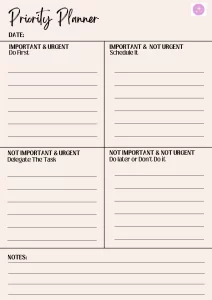If you haven’t used a priority worksheet to tackle a to-do list and maximize productivity, we are about to blow your mind!
A priority worksheet can make your life a million times easier. Our favorite type of priority matrix is the Eisenhower Decision Matrix.
Why would you use a priority worksheet you may ask? Well, a priority planner will allow you to categorize your to-do list, prioritize the tasks, and then tackle them one by one according to their importance and urgency.
We’ve all been there – there’s an endless to-do list and we tackle the tasks without rhyme or reason. Sometimes we make it through our to-do list and still have important and urgent tasks that we need to tend to.
If you get through part of your to-do list but there are still items that need immediate action, that means you may have handled items that were not urgent. The Eisenhower Decision Matrix takes the mystery out of the urgency and importance of tasks.
Using a priorities worksheet will allow you to create an action plan based on your top priorities.
But does the Eisenhower method work? We think so but you’ll need to try it out yourself!
You can categorize tasks according to their urgency and importance. Then, you’ll be able structure your to-do list so you get through the most important things first.
This priorities matrix aka the Eisenhower Matrix is used by many people who love time management. Created by President Eisenhower, it’s also called the Eisenhower box. Eisenhower signed the Civil Right’s Bill of 1957, ended the Korean War and helped us all prioritize our time.
Eisenhower also said: “Most things which are urgent are not important, and most things which are important are not urgent.” By using his matrix, you can decide for yourself!
Tips for Using a Priority Worksheet
When listing out your tasks, it’s important to also take difficulty of task and length of time into consideration.
Using the Eisenhower Decision Matrix for the first time can seem a bit foreign. When you first start using this kind of priority worksheet, you may want to write out the entire list of tasks then add them to the sections.
You can write in difficulty of task or length of task in your priority worksheet if you’d like.
If you absolutely need to complete a task that day, you’ll want that at the top of your list in the important and urgent section.
Another tip for using a priority planner is being consistent. Using the Eisenhower Matrix, you’ll want to use the priority planner for a week or longer time frame. This will allow you to get through your entire list. Now, if you have only a few things to do, you can still use the priority worksheet for that day.
Additionally, if you’re using the priority worksheet, make sure that you have it nearby and when you complete a task, check it off your list. If you do not look at it throughout the day, or you don’t check off the completed tasks, you might not get the most use out of it.
Keep reading to understand the different quadrants of the Eisenhower matrix and how to categorize your to-do list.
Categorizing Tasks that are Important and Urgent
When thinking about your to-do list, you’ll want to first understand the categories and quadrants.
Urgent and Important: These tasks absolutely need to be completed. These are tasks that need immediate action and will require urgent action because they are important. Consider this the must do list. This could be an important task at work with a deadline or a school project.
Urgent and Not Important: These are task that can be delegated. Urgent but not important may be home tasks that you can outsource. If you are absolutely slammed, you can Doordash groceries. Anything that can be outsourced is another way of thinking about these tasks that can be delegated. An example of this at work is having a team member run a meeting for you or send a report for you.
Not Urgent and Important: Think about things that are important but not necessarily urgent. Maybe you have something on your to-do list that’s important but you have a few days to get it done. This category is for things that need to be completed but you have more time to get them completed. An example is spending time with family, sending a bouquet of birthday flowers, or checking in with a work friend. These tasks can wait a day or two but they are still important.
Not Urgent and Not Important: Think about this section as things that can be done but don’t exactly need to be done. This is usually a range of activities that don’t benefit you. Doom scrolling online, watching tv mindlessly. If a task falls into this category, you usually don’t need to do it.
Other Great Ideas For Time Management
Once you have the Eisenhower Decision Matrix down, you can start crushing your goals! And don’t think small when going for time management. You can also implement this with coworkers and create an Eisenhower board at work.
This is just one great trick in your toolbox for maximizing your time. If you want some other time management tips, we suggest time blocking. Time blocking is scheduling time for specific tasks that you work through. This allows you to stay focused on one task at hand and get through it without distractions.
If you need to tackle emails, schedule a 1 hour block and only focus on handling emails.
Another time management technique you can utilize is using a Pomodoro Timer. By using a Pomodoro timer, you work through different tasks in 25 minute intervals.
Francesco Cirillo created the Pomodoro technique for a more productive way to work and study. Each interval is a pomodoro (tomato in Italian) because this is the shape of Francesco’s timer when he started using this technique.
Final Thoughts
We hope that you’ll be able to use this priority worksheet to make the most out of your day! When you prioritize your tasks, you can get through your to-do list and you might find that you have extra time on your hands. If you end up with some me-time, you can try out one of these after work routines or try out some new hobbies to invest in yourself!
If you like the Eisenhower Matrix Worksheet – let us know in the comments section! You’ll be able to access the Eisenhower Decision Matrix through canva.



3 comments
I really love this idea of using a priority worksheet to make the most out of my day. Between balancing two jobs and family, this is very helpful!
This is great! Thank you for sharing!
I’m loving this type of planner. I just created a calendar for 2023 for myself but now I may go back and redo it using this method. Thanks for the inspiration l!